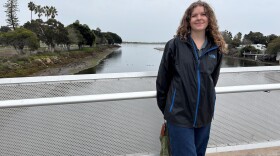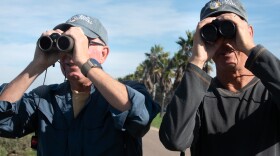CAVANAUGH: California officials have named this wildfire awareness week, and they have some disturbing predictions for this year's fire season. The state national resources director told reporters we should get ready for a deadly season of wildfires. And the governor says wildfires are getting more dangerous and Californians need to get prepared. GOV. BROWN: I'm going to do everything I can to deal with forest fires, but also with the whole problem of climate change. And the big issue, how do we adapt? CAVANAUGH: 40,000 acres have burned in California this month alone, most recently a 28,000-acre blaze in Ventura County, which is now under control. CAL FIRE and San Diego County fire officials are working together to get us ready for fire season. Joining me to talk about the preparation and how all of us can work to decrease fire risks are my guest, chief Tohm Porter of the San Diego County Regional Fire Authority, and CAL FIRE San Diego unit chief. Welcome. PORTER: Thank you, Maureen. It's good to be here. CAVANAUGH: And captain Mike Mohler in is with CAL FIRE. Welcome to the program. MULLER: Thank you for having us. CAVANAUGH: We've been through several days of rain and clouds. That must be good news for firefighters in Ventura. PORTER: These kind of rains reduce the fire danger while it's raining. As soon as the sun comes out, it'll dry the grasses, and we'll be back to where we were before the rain within hours. CAVANAUGH: Wow. Chief Porter, why is this shaping up as a particularly dangerous fire season? PORTER: Well, across the state, we have had a very dry winter. Snow packs are only about 17% of normal. So they haven't even made it to 20% of normal. And that is going to have a drying effect on the fuels over the season. We're already seeing fires burning and timber at this time of year that we would expect in late summer. So that's a big part of it. It's the way the weather pattern has delivered rain. Here in San Diego, we've been close to normal as far as rain. CAVANAUGH: Anything you want to add to that? In terms of why this particular season is shaping up to be dangerous? MULLER: Well, you've seen we had an early wind event. And if you talk to veterans throughout the fire service, in May we haven't seen this type of fire activity this early in May in years. The majority of the state went to where we've activated our additional staffing and aircraft weeks earlier than we normally would. Up in Northern California, one of the largest fires is the Panther fire, 7,000acres. But our coworkers up there were seeing crown fires, the tops of the trees, at this time of the year, something they don't normally see until July or August. CAVANAUGH: And if you could also explain a little bit more how that very, very low snow pack in the Sierra does actually increase fire risks. Tom Porter, since we don't have a wide range of mountains in San Diego County, I think it's hard for us to understand how that contributes to a more dangerous fire season. PORTER: What happens is the snow pack lasts well into the summer months. And it's a blanket of water on top of the ground and all the fuels that are underneath, the logs, the sticks, the flammable portions of the fuel bed. And it never covered most of the Sierra region this winter. So there was just a drying effect all winter long. So even when it rains, the moisture doesn't soak into those heavy fuels like it does when it's sitting under a snow pack for months on end. CAVANAUGH: So instead of getting that moisture from the snowing pack, they've just been out in the elements all year long drying out. PORTER: Absolutely correct. CAVANAUGH: Our reservoirs in Southern California are in pretty good shape, right? PORTER: Yeah. The reservoirs are in pretty good shape in Southern California. In Northern California, they're not recharging like we would like to see. And that has something to do with the way we get our water. We get our water through pipes that come from the Colorado River and from other distribution ways. And also surface runoff that comes from rain. In Northern California, primarily the reservoirs are filled by that snow pack melt. And the snow is just not there. CAVANAUGH: Now, Mike Muller, what is CAL FIRE doing to prepare for wildfire this is season? MULLER: Well, this is something that CAL FIRE, a large fire agency in the state and here in the county, we've activated our staffing. We have two different staffing model, we go from transitional, our entrance into increased staffing that we're getting close to what we consider peak. We brought that transitional staffing on early. And then with the fire activity, we went to what we consider peak staffing, the highest portion of our fire season which is year-round in California. We've increased staffing, brought all of our aircraft online. Here in San Diego, we brought our aircraft on weeks earlier. And as the governor stated, we have a great working relationship not only locally here with San Diego and our military pattern, but also the California National Guard that's supporting us with aircraft on immediate standby. So it's condition monitoring. And through chief porter and our units and statewide, we have to monitor conditions, but we're ready. CAVANAUGH: One of the things that Governor Brown was saying last year when he was campaigning for Prop 30 is that our public safety would see more dollars. Has CAL FIRE gotten a little bit more in this budget? PORTER: We've been held static. We haven't lost anything. There are dollars being made available for our early staffing to cover the cost of that on an emergency basis. So yes, we are getting more dollars in that respect. There's no base budget increase. CAVANAUGH: Now one of the things that come out today is that the head of the California National Guard, Major General David Baldwin, said that he's concerned sequestration cuts might affect the national guard's ability to play their role in help preventing fires, fighting fires this season. Have you had any conversations about that with the national guard? PORTER: Not with the national guard. That would be a conversation that happened in Sacramento with our director. And I am aware -- I just came from this meeting, Mike Muller and I just came from a military training exercise that's ongoing as we speak with the Marines and the Navy local. And they also have referenced that it may be more difficult to get the local helicopters due to sequestration as the summer moves on. But the details are not quite worked out on how that will happen here local. Resources and from cities, we can draw aerial resources from across the nation, and we can also draw on our patterns outside of the county to send us resources as we need. So I think we're in a pretty good state. Like I said in San Diego, we're in a little bit better fuel moisture state than the rest of California. So I anticipate we'll be supporting other fires outside of San Diego. CAVANAUGH: And one more question about resources and money. What impact do you think the closure of the air traffic tower at Ramona Airfield might have on fire-fighting operations this year? PORTER: Well, on that one, most recently I'm hearing that it may not be closing due to the air traffic controller agreements that have come through recently. CAVANAUGH: So you think that decision may be reversed? PORTER: That's what I'm -- the indications that I'm hearing are that. It's important to know that our fire-fighting aircraft fly in and out of uncontrolled air bases throughout the state daily. And it's not so much a safety issue for the fire-fighting aircraft as it is mixing in the traffic with the public airplanes that are flying around with the fire-fighting aircraft and making sure that that airspace is controlled. CAVANAUGH: Let me ask you, talk to us if you would about the strategy that we've seen fire-fighting agencies employ recently. You seem to hit these fires hard with just about everything you've got really right at the beginning. And captain Muller, tell us the idea behind that. MOHLER: Well, if you dial 911, not only CAL FIRE but San Diego and our local cooperators, we have different dispatch levels right now. We've moved to a high dispatch level. If someone sees fire in a vegetation area, we don't wait to confirm that. We are launching our engines, our aircraft, and our hand crews immediately medical we get someone on scene to confirm that. Some people say, wow, why do you launch all that equipment? Well, CAL FIRE, we keep 95% of our fires at 10acres or less because we have that. We hit them hard immediately. You can't have that lag time. So I think it attributes back to a latch dispatch immediately, and if it is a large fire, all the equipment is already on its way. CAVANAUGH: In the aftermath of the last big wildfires, we did hear some complaints from San Diego fire department about lack of resources and help from CAL FIRE to fight fires. There's a lot of that going on. Can you talk about what changes have been made to make sure that there's more sharing of resources? PORTER: Well, we work very closely throughout the year to plan for how we will respond to each other's incidents, whether if happens to be earthquake, flood, or other natural or man-made catastrophe or wildfire. So we have plans that allow us to share resources back and forth. There are times when either a local agency or CAL FIRE doesn't have additional resources to send. It doesn't mean we aren't ordering more resources from out of the area to come in, but it might take a little while for them to get here. So we all know that we're going to have to be self-sufficient for a period of time and take what resources we can get. And we are working well together in making plans to do so. CAVANAUGH: Since this seems to be shaping up to be a really bad fire season for Northern California, do you see any problem with shifting resources to Northern California and then seeing a fire break out down here in San Diego County? PORTER: That is always one of our main concerns. And I'm happy to say that also our regional coordinating center has that concern. We can't draw resources from the south, east, or west. They only come from the north. So if we send our resources north, we can be stripped very quickly. So there are plans that are already come place to keep San Diego with additional resources above what other operational units would draw down to. CAVANAUGH: I see. So what you're saying is there are units and resources that are going to stay here no matter what. PORTER: That's correct. CAVANAUGH: And those plans are already in place or are they being drawn up? PORTER: Those are already in place. And through our partnership with the county fire authority, we have the ability to put our career staff that may not have a state apparatus to get on, we can put them on the county equipment and add to the number of resources available locally. CAVANAUGH: Now we get down to how should people prepare. We hear this every year. But give it to us again. How do we need to get ready for this fire season? MOHLER: Well, this is a big portion of wildfire awareness week is defensible space. The camarilo fire, they did not have one home destroyod that fire. And a lot of it attributes to that defensible space. We have a website, readyforwildfire.org that the public can reference to. Three the 100feet of defensible space around your home, have an evacuation plan known for your family, and if you need to leave early, do so for the first responders so they can get in there. The defensible space gives the firefighters an opportunity to get in there and defend your home, and it helps your neighbor out. And is this the time to prepare for it. CAVANAUGH: Are there some extra things that people who live in the backcountry should do when it comes to their animals or any other thing about the fact that where they live is exceptionally prone to wildfire? MOHLER: Correct. And the east county residents or backcountry residents are unfortunately very well versed in wildfire and how to evacuate their animals. And that falls under that evacuation plan to make sure they know immediately upon having a fire out in the backcountry or anywhere that we have large animal rescue concerns, we dispatch large animal rescue units. But they need to know to have that contact information, have the animals ready and secured, and even so if they are asked -- if you have large animals and you are asked, it's time to go now and not wait. You're going to hit traffic, and the animals are going to panic when the fire gets closer. But you got to leave early and be prepared. CAVANAUGH: Tom, would you share with us anything that makes you especially nervous about this particular fire season? PORTER: Well, every fire season I'm nervous. I get the question, if it's rainy or if it's been dry, is this going to be a bad fire season? My answer is always yes. And this time of year, it's an exciting time of year because of the business we're in and we get to do the work that we're trained to do. But it's also the start of the scary season. We never want anyone to lose property or lives, nobody to get hurt by fires. And it happens every year. And the thing that people can do, the public can do to best protect themselves is get the defensible space and be prepared to leave when asked. CAVANAUGH: I want to thank you both. CAL FIRE captain Mike Muller, chief Tom Porter of the San Diego County regional fire authority. Thank you both very much. MOHLER: Thank you. PORTER: Thank you, Maureen.
The state natural resources director for California told reporters this week that we should get ready for a "deadly season" of wildfires. That was just one of the grim predictions made as Governor Jerry Brown declared this Wildfire Awareness Week."
The Governor said fire seasons are getting more dangerous and Californians need to get prepared.
“I’m going to do everything I can to deal with forest fires but also with the whole problem of climate change," Brown said. "But then the big issue of 'how do we adapt?'”
40,000 acres have burned in California since May 1. Most recently, a 28,000 acre fire burned in Ventura County. That fire is 95 percent contained.






